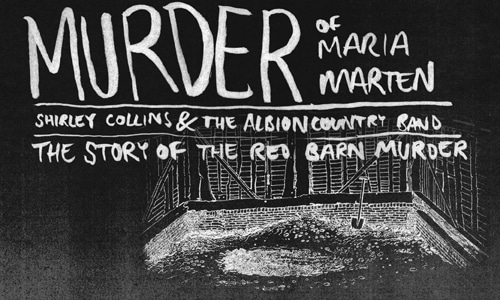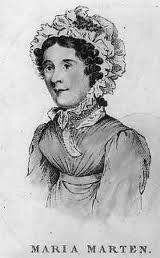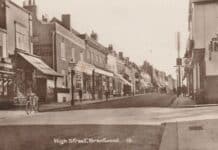Shirley Collins and The Albion Country Band created a 70s folk music classic based on the infamous 19th century Red Barn Murder of Maria Marten

Thwarted by a ghost?
A man has just committed murder. Sweating, he buries the bloody body and sits down out of breath. His spade slides away from him with a scraping sound. Sitting there on the cold earthen floor, he runs it all through his mind – no one saw me, I’m sure. No one will ever find the corpse. Will they?
What he hadn’t planned for though, was the ghost of his victim betraying him. By appearing to her stepmother in a dream, urging her to discover the grave where she lay rotting.
This is the case of Maria Marten, and the infamous Red Barn murder.
Cue music fading in. A folk-rock band plays a tune that is driven along by a fiddle on the left and a monkey-puzzle guitar on the right. Bass and drums hammer away behind. Then a singer starts – her high English voice telling the grisly tale. Promising, that the girl (Maria) will be married, whilst revealing at the same time, the protagonist (William) is lying.
“He straight went home and fetched his gun, His pickaxe and his spade. He went unto the Red Barn. And there he dug her grave.”

The music fades out as quickly as it started. Replaced by the eerie sound of a Hurdy Gurdy. You can hear its keys tap and its handle turn. Whirring away in a high-pitched drone screech, the Hurdy Gurdy accompanies the singer, as she becomes the killer. Confessing that he is resolved to take Maria’s life away.
Who was Shirley Collins?
This is the voice of Shirley Collins. Expressing the theatre of all it. Shirley Collins, who was born on the 5th July 1935, is a highly-regarded British folk singer. Awarded a MBE, she has contributed greatly to the folk revivals legacy.
Shirley grew up in a family who celebrated traditional song, so she started singing at an early age. After school, she found herself amidst the folk revival of the late fifties. Upon meeting Alan Lomax, she accompanied him to the American south on a folksong-collecting trip. On her return to Britain, she recorded several albums. Becoming part of the growing folk revival. In 1964 she made a seminal album with innovative guitar player Davey Graham called ‘Folk Roots New Routes’. She followed that with ‘Anthems in Eden’ in 1969 – a collaboration with her sister Dolly that incorporated the medieval music of David Munrow. In 1971 she married Ashley Hutchings (the bass player and leader in both Fairport Convention and Steeleye Span). The couple bonded over traditional music and he helped produce the album ‘No Roses’ in that same year.
Credited to Shirley Collins and The Albion Band, it features 27 musicians and singers, making it a celebration of the folk scene at the time. Most of the album has a merry jaunt, but one track in particular has a blackened heart. It’s the fourth track, ‘Murder of Maria Marten’, which was based on a folk song collected by Roud in 1908.
The band kicks back in, the deathly drone fades out. Now the murderer William Corder confesses his plans. After asking Maria’s hand in marriage they set a date. But, on that day he kills her instead and buries her body underneath the barn’s red earth floor.
“After the horrid deed was done, She laid there in her gore, Her bleeding mangled body lay, Beneath the red barn floor.”
What was the Red Barn Murder?
This is Mr. William Corder, famous Victorian Suffolk Murderer, whose death mask can be found in ‘The Moyse’s Hall Museum’ in Bury St Edmunds.
The case caused a sensation at the time. Questions were asked about how the mother knew where the body was, why the victim wore men’s clothing, and what happened to her baby?
William was born in 1803, the third son of a farmer from Polstead. After gaining a reputation as a ladies man, he took up with Maria in 1826. She was 24 years old, attractive and the mother of a boy named Thomas Henry, the product of an earlier affair. The pair met frequently at the red barn on the Williams land. A large wooden building covered with red tiles, hence its name.
Keen to marry, Maria soon fell pregnant. The infant died though and subsequently they both buried its corpse. This fact was later used against William in court because he hadn’t recorded the burial, so he was suspected of killing the infant too.
Six weeks after the infant’s death, William proposed with a ring and promised Maria they’d marry in Ipswich that very day. He dressed her in male clothing to avoid attention and asked to meet her at the barn. It was there that she met her fate.
Disappearing for a short time, William returned to the farm and told Maria’s parents he’d left his new bride in Ipswich. Her parents kept on asking questions though, which led William to leave, saying he was moving to the Isle of Wight with Maria.
Just after the murder, the stepmother’s dreams started. She dreamt that Maria was buried beneath the red barn, and they became so vivid that she persuaded her husband to dig up the earth floor. It was there in a sack, that they found the mangled remains of Maria.
Corder was tracked down and brought to trial. The event itself was rife with speculation, mainly due to a general disbelief of the dreams. An affair between William and the stepmother was rumoured to discount the supernatural explanation. Eventually though, Corder confessed that he’d shot Maria during an argument about their recently deceased child.
Three days later he was hung for the crime, a death mask was made and body parts preserved (his ear and scalp, now reside in the museum). His body had to be cut open to help the muscles relax during the hanging. Yet the crowds still looked on as his stomachs contents were revealed.
Once again the full band come back in to tell the tale of the murder. Nic Jones joins Shirley for the last few verses, and is a great foil to her delicate voice.
“She sent the father to the barn, Where he the ground did thrust. And there he found his daughter, Lay mingling with the dust.”
Recorded in the summer of 1971, the album was released that October. Later becoming an essential album in the folk-rock cannon.
The song ends on the drone. Shirley singing her adieu and telling that Corder is to be hung. He warns other young men of his fate.
“So all young men who do pass by, With pity look on me, For murdering of that young girl, I was hung upon a tree.”
The Hurdy Gurdy plays out, to be overtaken by the sound of a wooden cart passing. You imagine William led away to his gallows to the sound of creaking wood.
Did a ghost thwart William? We shall never know.
DOM COOPER is a graphic designer, illustrator and writer. He co-runs Rif Mountain Records and plays in The Straw Bear Band. Previously he played in The Owl Service, The Fiends and Wolfgang & The Wolf Gang. Dom is obsessed with music, and is interested in British folklore, history and culture. Follow him at @domcooperdesign | Find him at www.domcooper.com







